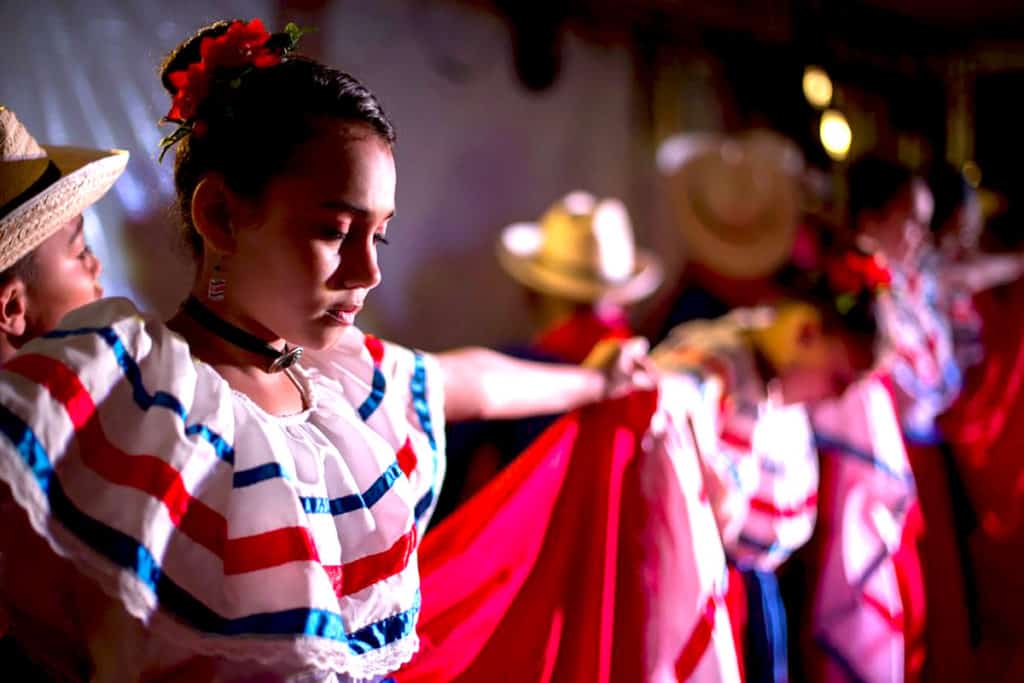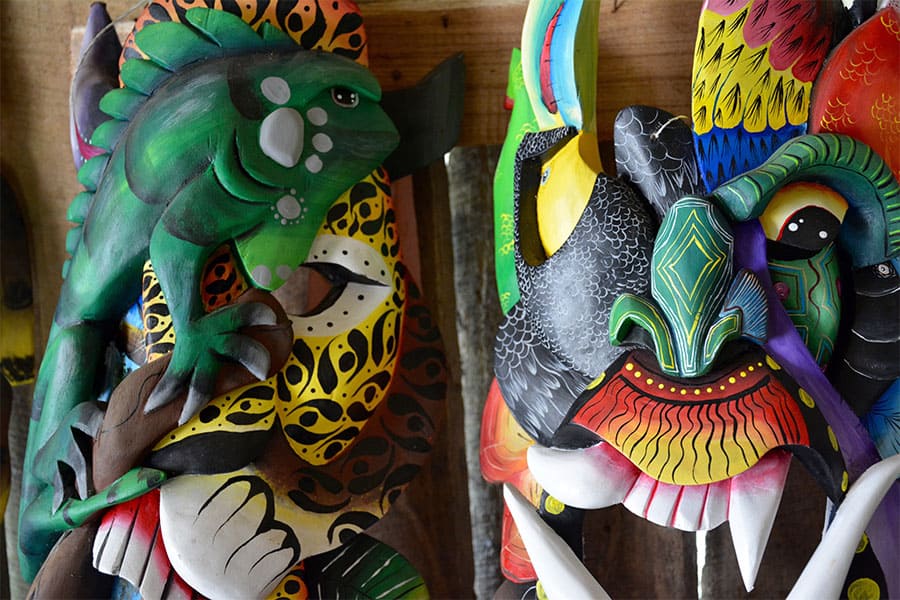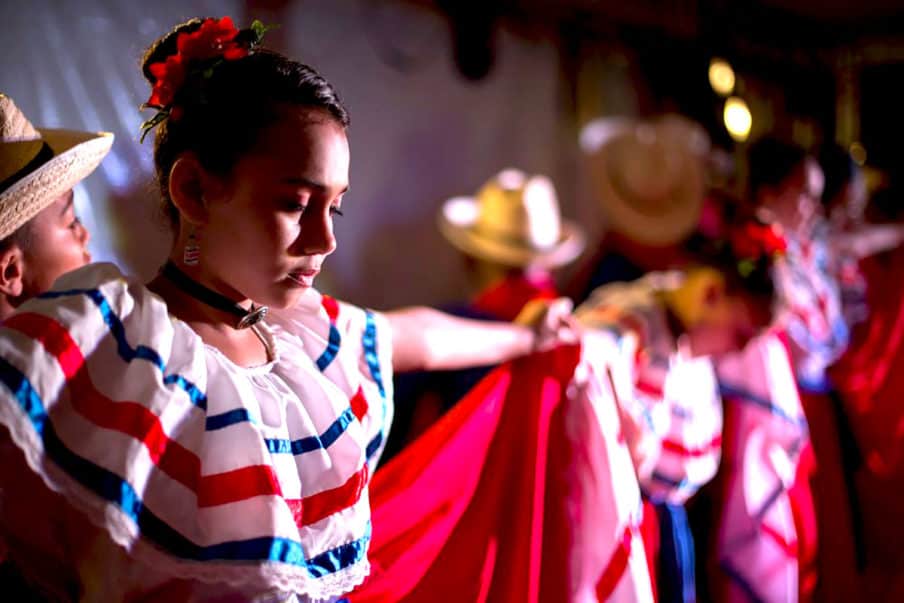
Costa Rica’s folkloric dances—Punto Guanacasteco, Suin Criollo, La Yeguita, Danza de los Diablitos, and Chorotega—are vibrant stories of the country’s past, told through lively steps and colorful costumes. Performed at festivals, these dances blend pre-Columbian, Spanish, and African influences, passing down traditions that celebrate love, resistance, and faith. Let’s explore their history, significance, and what makes each one special, with updates on their modern role in Costa Rican culture.
A Brief History of Costa Rican Folkloric Dances
Costa Ricans have danced for centuries, weaving their history into every step. Before the Spanish arrived in the 1500s, indigenous groups like the Chorotega and Boruca created dances for rituals and community events. Spanish colonizers brought zapateo footwork and stringed instruments like the guitar, while African slaves introduced polyrhythms and percussion, shaping the marimba-heavy music we hear today. Over time, these influences merged into a distinct Costa Rican style, with dances telling stories of rural life, spirituality, and defiance. Today, festivals, schools, and cultural programs keep these traditions alive, drawing locals and tourists alike.
Key Folkloric Dances of Costa Rica
Each dance carries a piece of Costa Rica’s soul, performed in regions like Guanacaste, Nicoya, and Boruca. Backed by marimba, guitar, and quijongo, they’re as educational as they are entertaining. Here’s a closer look at the main dances, plus a few others that add to the country’s rich heritage.
Punto Guanacasteco
Punto Guanacasteco, Costa Rica’s national dance, hails from Guanacaste and dates back to the 1830s. It’s a flirty courtship dance where couples form a circle, women twirling in colorful skirts called golas, and men waving hats or scarves while shouting playful verses. The marimba drives the rhythm, with stomping and clapping adding energy. It’s a bold display of romance, often seen at festivals like Santa Cruz’s Fiesta de la Tradición.
Suin Criollo
Suin Criollo, or Swing Criollo, is a 20th-century dance inspired by U.S. swing but adapted to Costa Rican music. Its bouncing steps and small kicks were once controversial, banned in the 1970s for being too modern. By the 2000s, it earned folkloric status and is now a festival favorite, showcasing Costa Rica’s ability to blend global influences with local flair.
La Yeguita
La Yeguita, performed every December 12 in Nicoya, celebrates the Virgin of Guadalupe. It retells a 1653 legend where twin brothers, fighting over a woman named Nantiume, were separated by a black mare sent by the Virgin. A dancer in a horse costume moves to flute and drum music, joined by others carrying the Virgin’s image in a procession. This dance, over 350 years old, blends indigenous and Catholic traditions, symbolizing cultural harmony.
Danza de los Diablitos
The Boruca tribe’s Danza de los Diablitos, held from December 30 to January 2 in Puntarenas, reenacts indigenous resistance against Spanish colonizers. Male dancers wear hand-carved cedar masks painted with jaguars or devils, symbolizing the Boruca as “little devils” fighting a bull (the Spanish). The masks are later sold, supporting the tribe’s economy. This three-day ritual, accompanied by drums and flutes, is a powerful statement of indigenous pride, recognized by UNESCO in 2023 for its cultural significance.
Chorotega Dances
The Chorotega people of Nicoya perform the Danza del Sol and Danza de la Luna, dances that share stories of coffee farmers, lovers, and ancient spirits. These performances, often staged for tourists, preserve oral traditions through graceful movements and marimba music. They highlight the Chorotega’s deep connection to nature and community.
Other Notable Dances
- Baile de los Indios: Performed in Talamanca, this dance honors indigenous rituals with simple, spiritual steps, often tied to harvest or ancestral ceremonies.
- Danza de las Mascaritas: Seen at carnivals, this playful dance features masked dancers in mestizo-inspired routines, blending humor and tradition.
- El Torito and La Cajeta: Popular in Guanacaste, El Torito mimics a bullfight, while La Cajeta pairs dance with candy-making, reflecting rural life.
Traditional Costumes: A Visual Story

Costumes are as vital as the steps, bringing each dance’s narrative to life. Women in Punto Guanacasteco wear golas—long, vibrant skirts that flare when spun—paired with white blouses and hair flowers. Boruca dancers in Danza de los Diablitos don cedar masks, woven sashes, and body paint, showcasing their craftsmanship.
La Yeguita dancers wear simple white outfits with red sashes, sometimes using horse-like props to mimic the mare. Men across these dances often sport white shirts, pants, straw hats, and scarves, adding flair with waves or fans. These outfits, blending native, Spanish, and African elements, turn performances into visual stories.
| Dance | Region | Key Features | Costume Highlights |
|---|---|---|---|
| Punto Guanacasteco | Guanacaste | Courtship, stomping, clapping | Golas skirts, white blouses, hats |
| Suin Criollo | Nationwide | Bouncing steps, small kicks | Modern attire, often colorful |
| La Yeguita | Nicoya | Religious procession, horse mimicry | White outfits, red sashes, horse props |
| Danza de los Diablitos | Boruca | Resistance narrative, three-day ritual | Cedar masks, woven sashes, body paint |
| Chorotega Dances | Nicoya | Nature and community stories | Simple traditional attire |
Modern Role and Preservation
These dances remain a living link to Costa Rica’s past. Festivals like Enamorate de tu Ciudad and Nicoya’s Virgin of Guadalupe celebration showcase them, while programs like SINEM teach kids the steps. In 2023, UNESCO highlighted Danza de los Diablitos in an exhibit, boosting its global recognition.
The Boruca continue selling masks to fund their community, and Guanacaste’s marimba music thrives at events like the Festival Nacional de Danza. Visitors can experience these traditions at cultural tours in Guanacaste or Monteverde, where workshops teach marimba or dance steps.
Final Thoughts
Costa Rica’s folkloric dances are a window into its history, blending indigenous, Spanish, and African roots into stories of love, faith, and resistance. Whether it’s the flirty spins of Punto Guanacasteco or the defiant masks of Danza de los Diablitos, each performance is a celebration of Pura Vida. Catch a show at a local festival, support Boruca artisans, or join a workshop to connect with this vibrant heritage. These dances aren’t just steps—they’re Costa Rica’s heartbeat.

